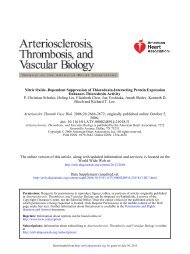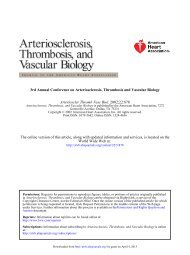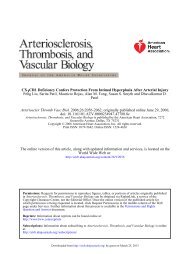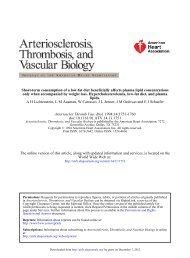Physiologic and Supraphysiologic Increases in Lipoprotein Lipids ...
Physiologic and Supraphysiologic Increases in Lipoprotein Lipids ...
Physiologic and Supraphysiologic Increases in Lipoprotein Lipids ...
You also want an ePaper? Increase the reach of your titles
YUMPU automatically turns print PDFs into web optimized ePapers that Google loves.
414 ARTERIOSCLEROSIS VOL 4, No 4, JULY/AUGUST 1984<br />
Table 6. Hypercholesterolemla In Pregnancy:<br />
Subject A.M.<br />
Whole plasma<br />
Triglyceride<br />
Cholesterol<br />
VLDL (mg/dl)<br />
Triglyceride<br />
Cholesterol<br />
Apo B<br />
LDL (mg/dl)<br />
Triglyceride<br />
Cholesterol<br />
Apo B<br />
HDL (mg/dl)<br />
Triglyceride<br />
Cholesterol<br />
Apo A-1<br />
Pregnant<br />
Week 36<br />
(mg/dl)<br />
226 (387)<br />
326 (318)<br />
87 (246)<br />
15 (47)<br />
20<br />
98 (113)<br />
230 (218)<br />
116<br />
23 (21)<br />
60 (42)<br />
164<br />
Postpartum<br />
Week 6 Week 20<br />
118 (157)<br />
250 (265)<br />
40 (122)<br />
9 (29)<br />
11<br />
50 (36)<br />
167 (177)<br />
184<br />
13 (4)<br />
59 (44)<br />
150<br />
105 (160)<br />
254 (240)<br />
20 (112)<br />
4 (28)<br />
4<br />
68 (28)<br />
181 (159)<br />
103<br />
11 (4)<br />
52 (33)<br />
150<br />
A.M.'s <strong>in</strong>fant's birth weight was 2789 g. A.M. breast fed<br />
for 8 weeks postpartum.<br />
Parentheses denote 95th percentiles for total, VLDL,<br />
<strong>and</strong> LDL lipids <strong>and</strong> 5th percentile for HDL lipids. Values for<br />
36 weeks of gestation <strong>and</strong> 6 weeks postpartum are based<br />
on a study of 553 pregnant women (see reference 5);<br />
values for age 30-39 nonpregnant, nonhormone-tak<strong>in</strong>g<br />
subjects (Week 20) are from reference 6.<br />
242 (>90th age-specific percentile), a total-cholesterol<br />
of 257 (>75th percentile), an LDL cholesterol of<br />
181 (~90th percenile), <strong>and</strong> an HDL cholesterol of 37<br />
(~15th percentile). The mother's lipoprote<strong>in</strong>s were<br />
close to the median values for her age <strong>and</strong> sex: total<br />
triglyceride, 149; total cholesterol, 227; LDL cholesterol,<br />
175; while her HDL cholesterol, 72 mg, was<br />
near the 75th percentile. Thus, there is evidence for<br />
elevated total triglyceride <strong>and</strong> LDL cholesterol <strong>in</strong> a<br />
first degree relative of DR.<br />
Three other subjects with supraphysiologic triglyceride<br />
<strong>in</strong>creases <strong>in</strong> pregnancy are compared to DR <strong>in</strong><br />
Table 5 <strong>and</strong> are also illustrated <strong>in</strong> Figure 3. One of<br />
these women, subject CB, was the mother of two<br />
hypertriglyceridemic children with fast<strong>in</strong>g chylomicronemia<br />
<strong>and</strong> plasma triglyceride levels of 6460 <strong>and</strong><br />
796 mg/dl at ages 3 <strong>and</strong> 1, respectively, on an unrestricted<br />
diet. CB's parents had triglycerides at the<br />
75th <strong>and</strong> 90th percentiles <strong>and</strong> cholesterol at the 75th<br />
percentile. 68 CB therefore appears to be an obligate<br />
heterozygote for the Type I phenotype. YF's brother<br />
(aged 29) had total <strong>and</strong> LDL cholesterol concentrations<br />
(237 <strong>and</strong> 163 mg/dl, respectively) at or above<br />
the age- <strong>and</strong> sex-specific 95th percentiles (222 <strong>and</strong><br />
165 mg/dl) <strong>and</strong> a total triglyceride concentration (135<br />
mg/dl) >90th percentile. YF's father had average<br />
lipoprote<strong>in</strong> lipid concentrations. Thus, there is an association<br />
of hyperlipidemia <strong>in</strong> a first degree relative<br />
of YF. The relatives of FS were not available for<br />
study.<br />
All four subjects were below the 95th percentile<br />
values for total plasma triglycerides either before<br />
Downloaded from<br />
http://atvb.ahajournals.org/ by guest on June 29, 2013<br />
pregnancy or 20 weeks postpartum, but were markedly<br />
above the 95th percentile <strong>in</strong> late gestation. All<br />
subjects showed a delay <strong>in</strong> the postpartum decl<strong>in</strong>e of<br />
total triglyceride concentrations compared with normal<br />
subjects, <strong>in</strong> that at 6 weeks postpartum, total<br />
triglyceride concentrations were consistently above<br />
the 95th percentile (Table 5 <strong>and</strong> Figure 3). Similar<br />
trends were observed <strong>in</strong> VLDL triglyceride <strong>and</strong> cholesterol<br />
(data not shown). Disparate responses were<br />
seen among the four subjects with respect to total<br />
<strong>and</strong> LDL cholesterol ante- <strong>and</strong> postpartum. DR was<br />
the only subject show<strong>in</strong>g a comb<strong>in</strong>ed elevation of<br />
triglyceride <strong>and</strong> cholesterol <strong>in</strong> pregnancy. All others<br />
had abnormal <strong>in</strong>creases only <strong>in</strong> total <strong>and</strong> VLDL triglyceride.<br />
Another dist<strong>in</strong>ction was the LDL cholesterol<br />
fall at 6 weeks postpartum <strong>in</strong> DR, but a rise <strong>in</strong> the<br />
other three. The 20-week postpartum or prepregnancy<br />
LDL cholesterol concentrations <strong>in</strong> these three<br />
subjects were also higher than the pregnancy levels.<br />
HDL cholesterol concentrations were not as low <strong>in</strong><br />
subjects FS, YF, <strong>and</strong> CB as <strong>in</strong> subject DR, but were<br />
near or below the 5th percentiles both ante- <strong>and</strong><br />
postpartum.<br />
Hypercholesterolemic subject AM is presented <strong>in</strong><br />
Table 6 <strong>and</strong> <strong>in</strong> Figure 3. She was not on a cholesterol-restricted<br />
diet at the time of the study. Total plasma<br />
cholesterol concentrations were similar at 6 <strong>and</strong><br />
20 weeks postpartum, but were near or above the<br />
95th percentile value. VLDL lipids <strong>and</strong> apo B were<br />
consistently normal (compare the apo B results with<br />
those <strong>in</strong> Table 2). The LDL cholesterol concentration<br />
was above the 95th percentile at 36 weeks of gestation,<br />
5 fell postpartum to slightly below the 95th percentile<br />
at 6 weeks, but exceeded the 95th percentile<br />
at 20 weeks. 6 Compared with 6 <strong>and</strong> 20 weeks postpartum,<br />
the LDL cholesterol rise due to pregnancy<br />
was 49 to 63 mg/dl. The apo B concentration was<br />
about 40 mg/dl above the average at 36 weeks of<br />
gestation <strong>and</strong> 20 weeks postpartum, but <strong>in</strong>creased to<br />
80 mg/dl above the average at 6 weeks postpartum,<br />
an exaggeration of the pattern observed <strong>in</strong> normal<br />
subjects at 6 weeks postpartum (Table 2). HDL lipids<br />
were fairly typical <strong>in</strong> this patient; however, apo A-l did<br />
not fall postpartum as much as expected.<br />
A familial heterozygous hypercholesterolemic<br />
woman with tendonous xanthomas (subject NC) was<br />
studied at 37 weeks of gestation <strong>and</strong> 6 <strong>and</strong> 20 weeks<br />
postpartum. The patient was on a cholesterol-restricted<br />
<strong>and</strong> polyunsaturate-supplemented diet<br />
throughout. Total cholesterol was 614 mg/dl <strong>and</strong> total<br />
triglyceride, 232 mg/dl at 37 weeks of gestation.<br />
Postpartum, 6- <strong>and</strong> 20-week total cholesterol concentrations<br />
were 554 mg/dl <strong>and</strong> 530 mg/dl with cholesterol<br />
concentrations <strong>in</strong> VLDL of 20 mg/dl <strong>and</strong> 24<br />
mg/dl; LDL, of 484 mg/dl <strong>and</strong> 444 mg/dl; <strong>and</strong> HDL, of<br />
60 mg/dl <strong>and</strong> 62 mg/dl. In NC the total cholesterol<br />
rise <strong>in</strong> pregnancy (compar<strong>in</strong>g 36 weeks of gestation<br />
<strong>and</strong> 20 weeks postpartum) was 84 mg/dl, only slightly<br />
higher than the total cholesterol <strong>in</strong>crement observed<br />
<strong>in</strong> 23 normal women over the same <strong>in</strong>terval<br />
(61 mg/dl). The conclusion from hypecholesterole














